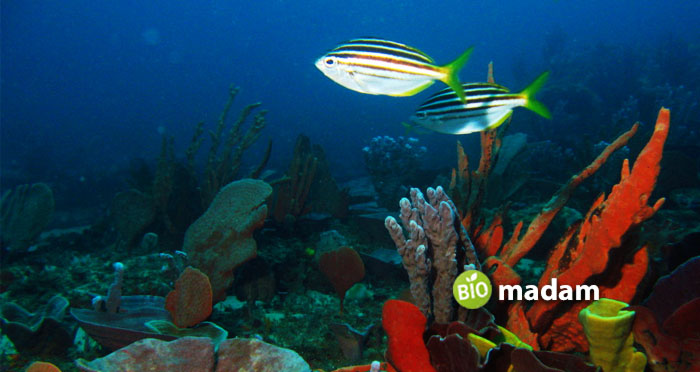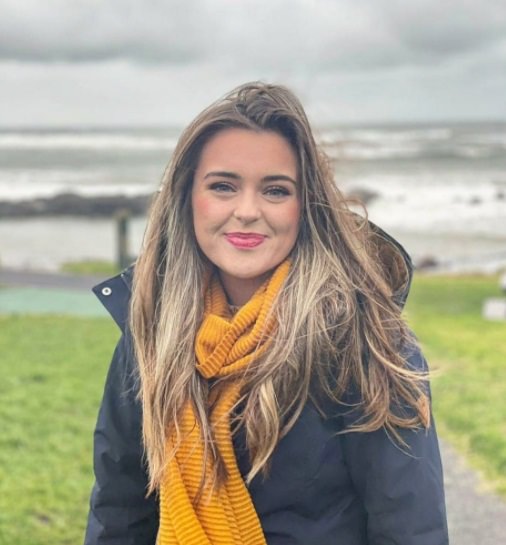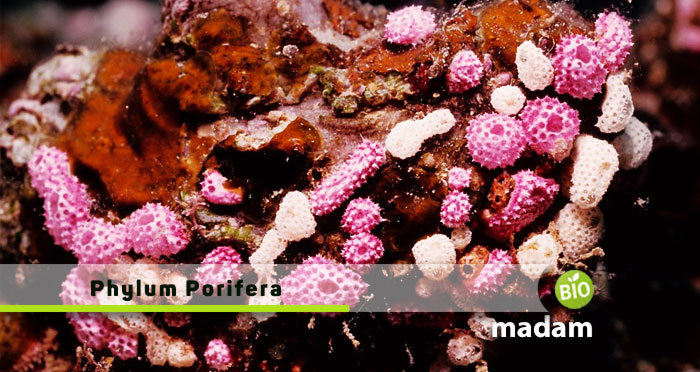Porifera are a group of eukaryotic organisms commonly known as sponges. They are believed to have existed since the Late Precambrian era. Studies show that an early branching event separated the members of Porifera from other metazoans. Porifera are often confused with algae, fungi, and plants, but they belong to the kingdom Animalia. While they have the same basic features, a few of their characteristics help researchers categorize them into different classes. Keep reading to know all about the types of Porifera and the phylum in general.
Phylum Porifera
Phylum Porifera is the oldest animal phyla comprising organisms that look like sponges. They are heterotrophic organisms with over 5,000 species on the planet. The presence of a feeding system distinguishes sponges from other organisms. They feed through pores in their walls instead of ingesting food through their mouth. However, the pores only allow filtered water into the body and remove all extra substances. The action of flagella drives the movement of water through the sponge in one direction. You might be surprised to know that the cells of sponges are more independent of each other than other animals.
Characteristics of Phylum Porifera
- Porifera typically lives in marine habitats, yet they might also be found in freshwater.
- They have a cylindrical or vase-shaped body.
- The cells in the body of sponges are loosely organized.
- Sponges do not have a tissue or organ level organization.
- They obtain their nutrition through canals in the form of pores.
- They have multiple pores called osculum and ostia.
- Porifera reproduce asexually by binary fission, fragmentation and budding.
- They can regenerate their lost parts.
- They do not have a specific nervous system, but have neurosensory cells.
- Sponges exchange nitrogenous waste or gasses through diffusion and osmosis.
Let’s tell you the types of Porifera with their distinct characteristics.
Types of Porifera
Phylum Porifera is majorly categorized into three classes: Calcispongiae (Calcarea), Hyalospongiae (Hexactinellida), and Demospongiae.
Calcispongiae
Class Calcispongiae, also known as Calcarea, is a group of calcareous sponges. They are coastal water species and do not live under 100 meters. They are also found in rocky bottom habitats and communities. Calcispongiae has a narrow osculum placed terminally, rich with an oscular fringe. It prevents the entry of other organisms into the sponges. The asconoid canal system of this class is unique from other classes. The members of this class may also have leuconoid or syconoid canal systems.
Some other characteristics of calcispongiae include:
- Their skeletons are made of calcium carbonate.
- Members of this class have a vase-shaped or cylindrical body and exhibit radial symmetry.
- They are small-sized, no more than 10 cm in height.
- The free calcareous spicules in the skeleton contain more CaCO3 than MgCO3.
Members of Calcispongiae are: Calcispongiae, L. Calcis and Calcarea, L. Calcarious.
This class is further divided into two orders: Homocoela and Heterocoela.

Homocoela
- Small bodies
- Asconoid sponges
- Thin body wall
- Lined with choanocytes
Heterocoela
- Larger bodies than homocoela
- Leuconoid and syconoid sponges
- Thick body walls
- Internally folded skeletal structure
Hyalospongiae
The next class of this phylum is Hyalospongiae, also known as Hexactinellida or Triaxonida. These sponges are also referred to as Glass Sponges. Hyalospongiae are large-sized sponges that typically live in deep waters and grow in soft or firm sediments. Some of the organisms of this class may be found up to 1000 meters under the sea. Their skeletons exist as separate entities in the form of networks. You can distinguish the microscleres and megascleres in the anatomical structure. The walls enclose an atrium that opens by a wide osculum.
Characteristics of members of Hyalospongiae are:
- Large-sized sponges
- 10 to 30 cm in height on average
- Appearance like a vase with a foot
- No cellular dermal epithelium is present
- Leuconoid or syconoid canal system
- They comprise 86% SiO2, 9% water, 3% organic elements, and 2% Speculum.
Venus’s flower basket and Hyalostylus are examples of Hyalospongiae
This class also comprises two orders: Hexasterophora and Amphidiscophora.
Hexasterophora
- Hexaster spicules
- Flagellated chambers or radial canals
Amphidiscophora
- Open-ocean species
- Amphidisc spicules
Demospongiae
Demospongiae comprises three subclasses and 7 orders. 90% of all sponges are demospongiae. They are found in marine biomes and ecosystems, but some live in shallow waters. The members of this class are widely spread in various beautiful colors due to the presence of pigment granules. They may or may not have a skeleton. The silicious megasclere is not 6-rayed. The freshwater biodiversity of demospongiae has contractile vacuoles to remove water from the cells.
Characteristics of demospongiae are:
- Leuconoid canal system
- Rounded, small, flagellated chambers
- The morphology derived from the rhagon-type larval stage
- Parenchymula larval life cycle
Sub-classes of Demispongiae include the following:
Tetractinellida
- Flattened or rounded body
- Un-branched structure
- Tetragon siliceous spicules
- Spicules may be present or absent
Orders of the sub-class Tetractinellida include Myxospongida, Homosclerophora, and Choristida.
Keratosa
- Spongin fibrous skeleton
- Siliceous spicules are absent
Monaxonida
- Rounded body with fan-shaped or funnel shape
- Monaxonial megas¬cleres spicules
- Spongin may be present or absent
The four orders in this sub-class include Hadromerina, Halichondrina, Poecilosclerina, and Haplosclerina.

The Bottom Line
Porifera or sponges are an important part of different types of ecosystems, especially marine and freshwater habitats. They are made of silicon and have a canal system for transporting nutrients and water in the organism. The three main types of Porifera are calcispongiae (Calcarea), hyalospongiae (hexactinellida), and demospongiae. Despite their distinct characteristics, all classes of Porifera have a similar, cylindrical, symmetric body. They possess cellular-level organization. Porifera reproduce asexually, and not by sexual reproduction. They follow the process of fragmentation, binary fission, and budding and can regenerate their lost parts.
FAQs
Who discovered Porifera?
Ellis (1755), Pallas (1766), and Ellis & Solander (1786) discovered Porifera first as being animals. It is believed that they existed for over 760 million years during Precambrian times. They are thought to have emerged from choanoflagellates 1020 million years ago.
What are the two examples of Porifera?
Examples of Porifera include Spongilla, a freshwater sponge, and Euspongia, a bath sponge.
What is the function of Porifera?
Sponges absorb dissolved organic matter and consume ultraplankton. They are a nitrogen source for coral reefs and create an important coupling point in the ecosystem. Sponges also help filter water by collecting archaea, bacteria and processing nitrogen, carbon, and phosphorus.

Hello, I would like to introduce myself to you! I am Chelsea Rogers, an experienced blog writer for science articles, holding an MPhil degree. My enthusiasm to grab the best knowledge, let it relate to botany, zoology, or any other science branch. Read my articles & let me wait for your words s in the comment section.

